In September 2021, we surveyed Washington’s cities to learn about current city conditions.
Here's a snapshot of what we learned.
Who took the survey?
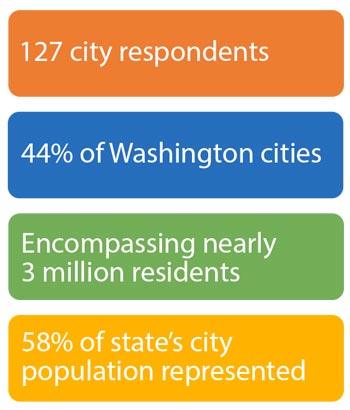

What we found
Cities reported the following as the most pressing community conditions in 2021.

Source: 2021 AWC City Conditions Survey, 124 responses
Notably, many of the top community concerns match the responses when we asked a similar question in 2019 and 2020. However, city infrastructure conditions jumped back into the top spot, and transportation continues to climb.
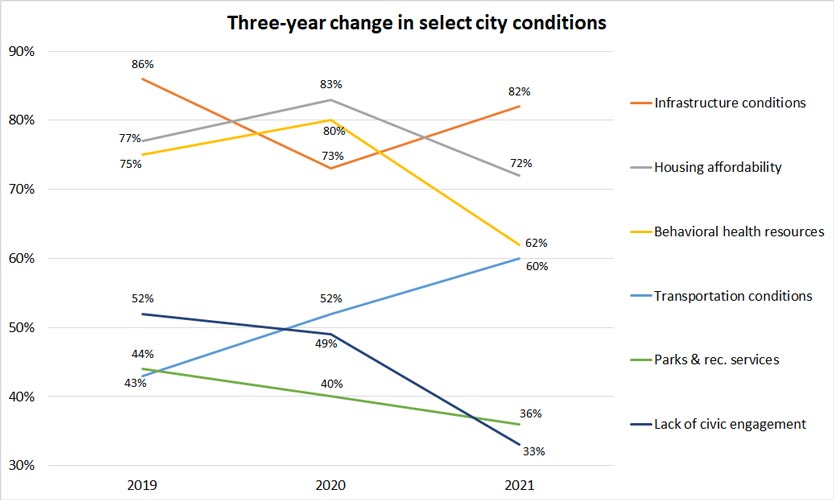
Sources:
2021 AWC City Conditions Survey, 124 responses
2020 AWC City Conditions Survey, 121 responses
2019 AWC City Conditions Survey, 132 responses
It’s also worth noting that the community concern over a lack of civic engagement went down over three years, perhaps due to cities increasing their remote engagement opportunities during the pandemic and thus seeing an increase in civic engagement.
The top pressing community conditions align well with what assistance cities look for from the state. When asked what actions would help a city meet its needs, at 90 percent—respondents overwhelmingly support increased local infrastructure
funding.
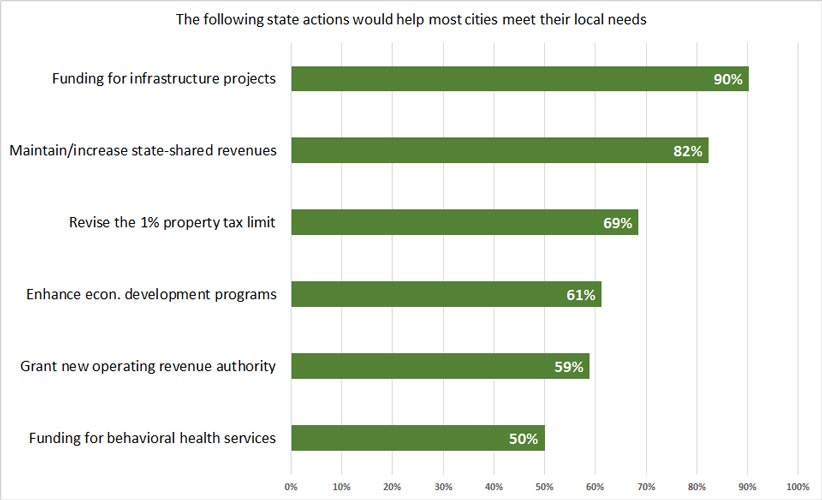
Source: 2021 AWC City Conditions Survey, 124 responses
Cities also look for a partnership with the state—but what form that takes depends on many factors, including where a city is located and how many residents it supports. That’s why, following infrastructure funding, we see that cities are
largely interested in protecting state-shared revenues and revising the 1% property tax cap. Both of which would sustain and provide flexible city funding.
Asked to select their top local policy issues for 2022, infrastructure, public safety, and economic development rise to the top in cities. This closely matches what cities said last year about their policy focus in the coming year, with public safety
receiving additional attention.
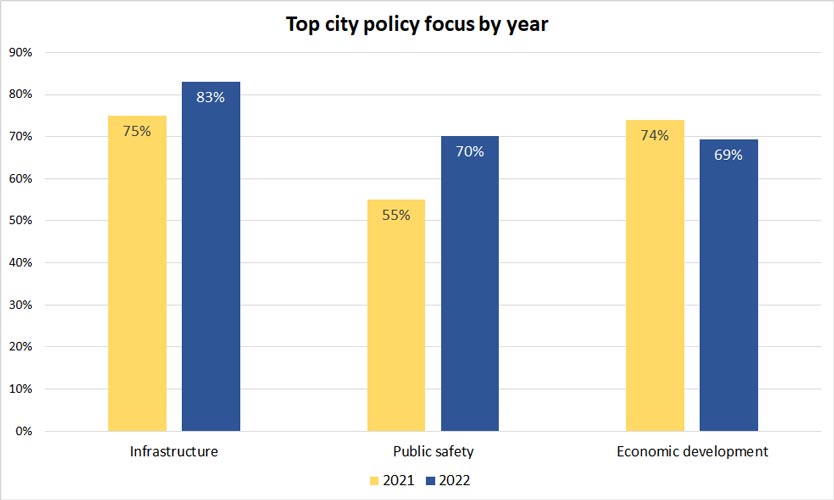
Sources:
2021 AWC City Conditions Survey, 124 responses
2020 AWC City Conditions Survey, 118 responses

COVID-19 & cities
In early 2021, the American Rescue Plan Act passed providing 1.1 billion dollars in direct allocations to Washington’s cities. This sweeping federal funding is bringing much-needed financial relief to local governments and reducing the strain cities face due to pandemic impacts on the economy and local budgets alike.
We asked cities a series of questions about their funding levels in light of the COVID-19 pandemic. Here’s what we learned:
Interestingly, cities are consistent when projecting their budget revenue losses:
- In 2020, we asked about realized 2020 revenue losses and projected 2021 revenue losses; and
- In 2021, we asked about realized 2021 revenue losses and projected 2022 revenue losses.
62% of cities said they projected 2021 losses and 62% of cities again said they saw 2021 losses this year.
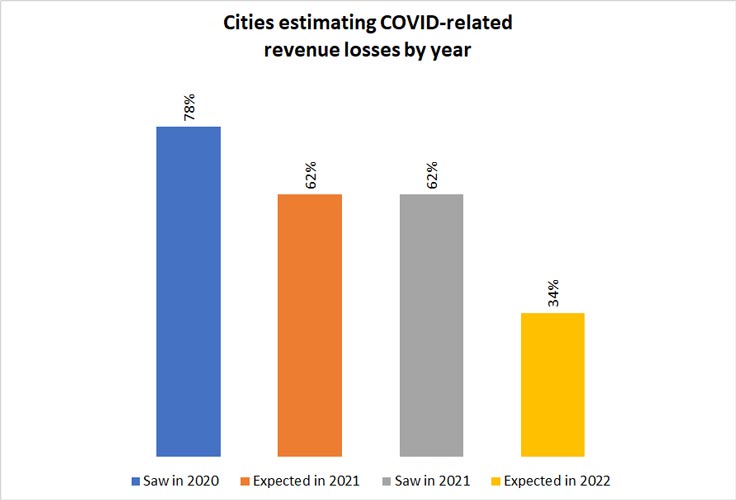
Sources:
2021 AWC City Conditions Survey, 125 responses
2020 AWC City Conditions Survey, 124 responses
If cities are as good at predicting their losses year-after-year, we can reasonably expect that 1/3 of cities will still see revenue losses in 2022, although to a lesser degree (Nearly 75% of cities project budget cuts
under 10%). But while ARPA funds were critical to helping cities stay afloat, the situation is far from over. Read the COVID-19 budget impacts below or scroll to the next chapter on city finances.
In 2021…
- 62% of cities projected revenue losses this year due to the pandemic (prior to ARPA funds).
Source: 2021 AWC City Conditions Survey, 125 responses - 58% of cities still expect revenue losses to occur (even after ARPA funding).
Source: 2021 AWC City Conditions Survey, 78 responses
Of those cities with revenue losses, 42 cities indicated the degree that losses impact their budget. 22 cities saw losses under 10%, while 20 cities saw losses as great as 12-50%. It breaks down like
this:
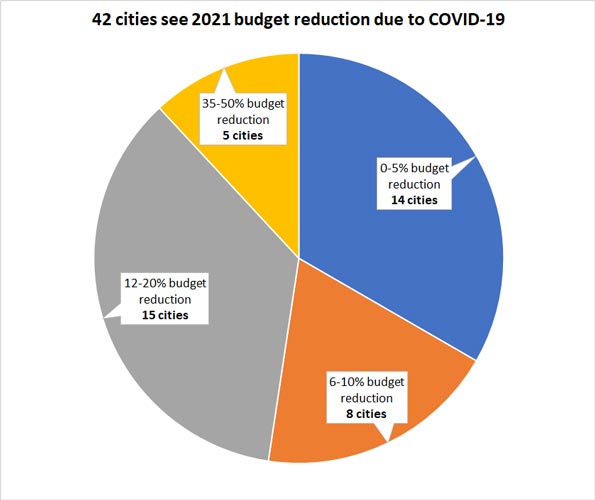
Source: 2021 AWC City Conditions Survey, 42 responses
The cities projecting a 12-50% budget reduction are spread throughout the state and include some of our state’s smallest towns and largest cities.
It’s not surprising to see the breakdown of taxes and fees where more cities are seeing decline this year. That's because the pandemic has impacted local sales, travel and lodging, utility collection, fuel consumption, parks activity, and more.
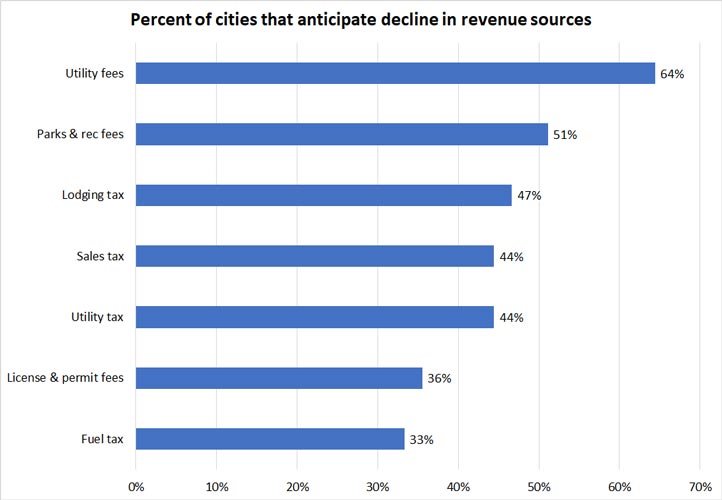
Source: 2021 AWC City Conditions Survey, 45 responses
In 2022…
The situation is less dire for projected 2022 city budgets.
- 34% of cities project revenue losses in 2022 due to the pandemic.
Source: 2021 AWC City Conditions Survey, 124 responses
Of those, only 39 cities predict budget reductions in the coming year and the vast majority expect to see budget losses under 10%.
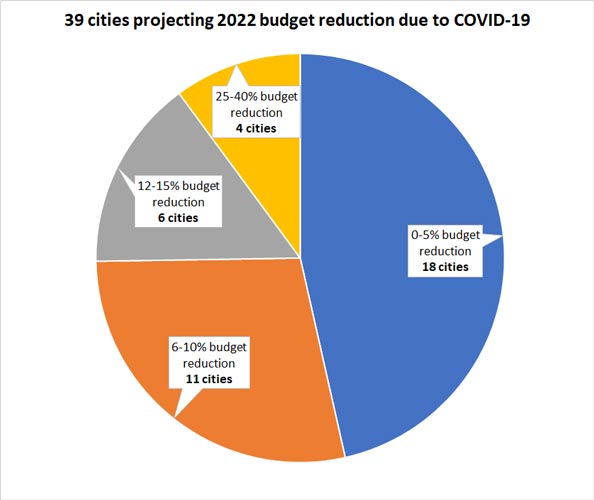
Source: 2021 AWC City Conditions Survey, 39 responses
Cities stepped up to minimize the impact of budget reductions on the community and maintain high-quality levels of service. In order to ease the impact of declining funds, cities implemented tools and cost-saving measures similarly to last year. The top
cost-saving strategy again included eliminating city staff travel and training. But cities were more likely to cancel and postpone capital projects in 2021 compared to last year.
However, cities were much less likely to freeze hiring and spending compared to last year—as cities still need to hire employees and keep city halls running smoothly in the 18 months since the start of the pandemic.
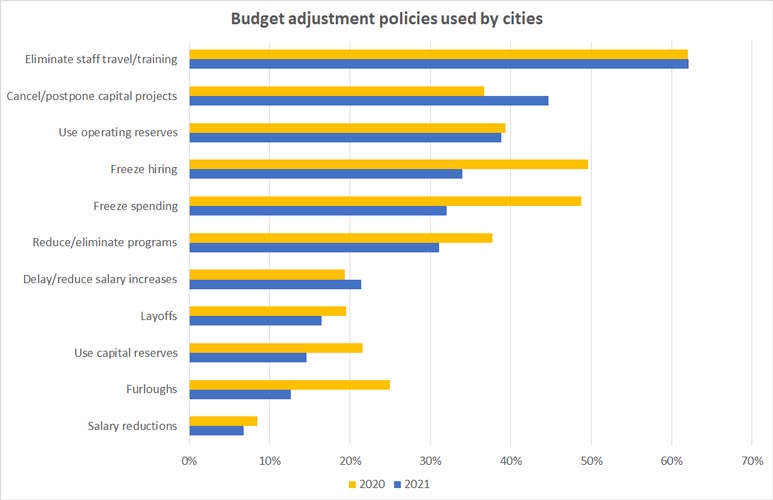
Sources:
2021 AWC City Conditions Survey, 103 responses
2020 AWC City Conditions Survey, 122 responses
Cities throughout the state share concern over the impact of the COVID-19 pandemic on their local businesses and residents. Some cities reported reaching out to struggling locals to provide direct assistance in the following ways.
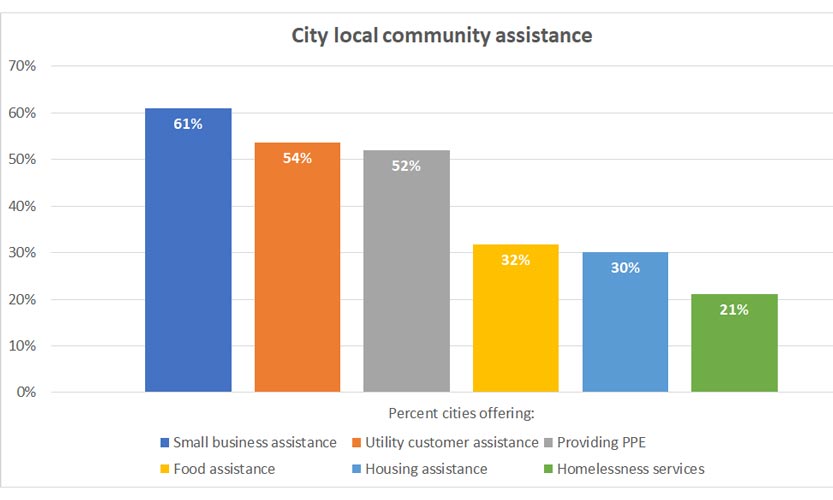
Source: 2021 AWC City Conditions Survey, 123 responses
When it comes to ARPA funds, almost all cities have reported receiving their first tranche of funding. Here are some of the top spending categories in cities:
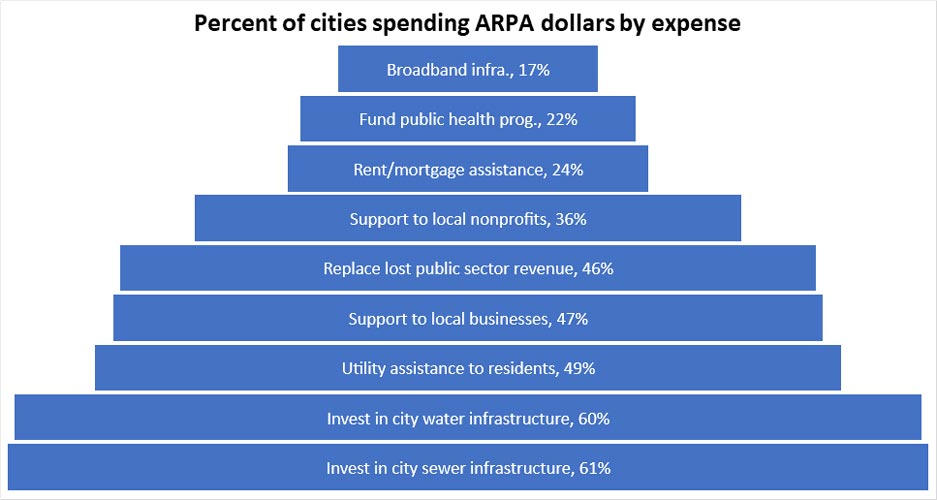
Source: 2021 AWC City Conditions Survey, 122 responses

Finance
Roughly 60% of cities report their revenues are generally keeping up with expenditures—but cities report that when their expenditures are exceeding revenues, it’s an indicator of a short- and long-term problem: COVID-19 and
prolonged structural deficits.
Most cities have experienced at least a 5% reduction in their annual budget due to COVID-19 economic impacts. This impact is felt the greatest with utility tax and fee revenue, followed by sales and use tax revenue.
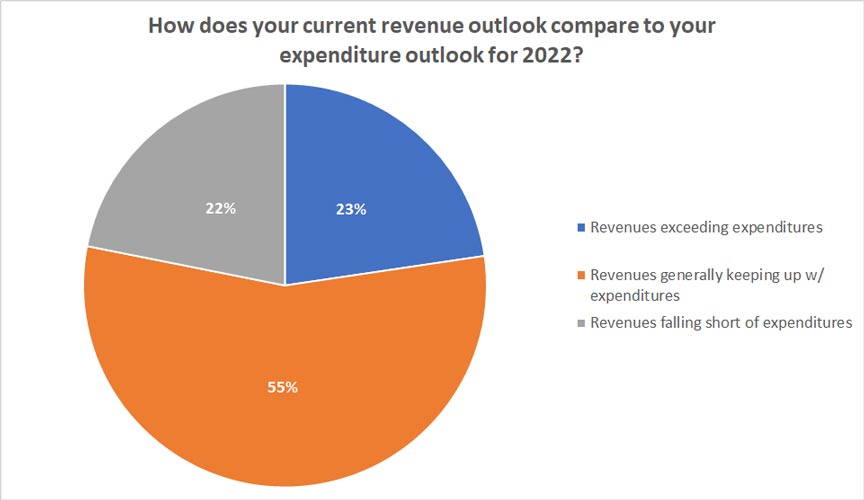
Source: 2021 AWC City Conditions Survey, 124 responses
While about 30% of cities report that they continue to project COVID-19 related deficits in 2022, nearly the same amount of cities are using, or plan to use, the fiscal flexibility options provided in AWC’s priority bill from the
last legislative session: HB 1069. Most notably, cities are using additional REET flexibility and extended utility lien authority to address the most pressing community needs.
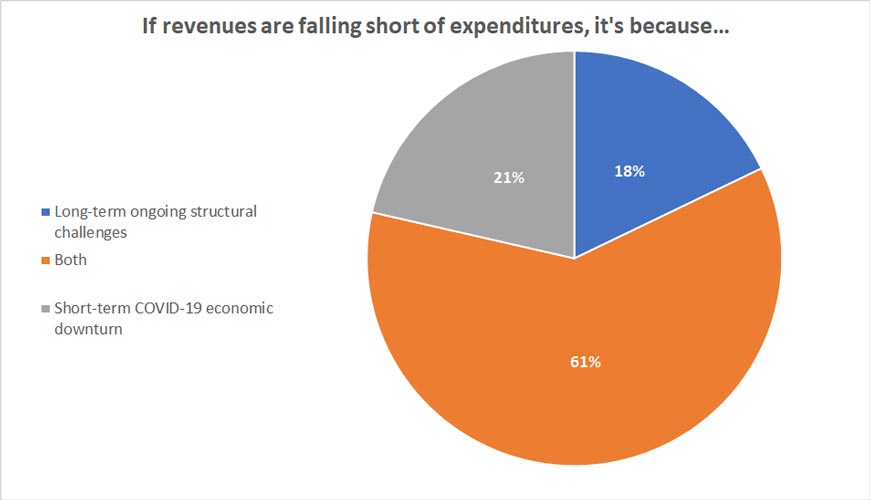
Source: 2021 AWC City Conditions Survey, 26 responses

Infrastructure
Cities overwhelmingly report that the age of their water and wastewater facilities is of top concern for their community. This aligns closely with the American Society of Civil Engineers (ASCE) recent “Infrastructure Report Card” for the state:
Washington’s water and wastewater systems were rated as a “C-” due to their accumulated, rapid decline.
Unsurprisingly, the second-ranked concern for cities was the unaddressed utility arrearages incurred during the utility shutoff and late fee moratorium—nearly 90% of respondents reported significant pandemic-related delinquencies.
This concern continues to be a top priority for city-owned utilities as the state recovers from the pandemic.
Many cities rely on several state grant and loan programs to address extensive capital projects in their jurisdiction. However, we know these revenue sources are not enough to meet the diverse needs of cities. It’s imperative that our cities receive
support from the potential federal infrastructure package and remain at the forefront of infrastructure investments.
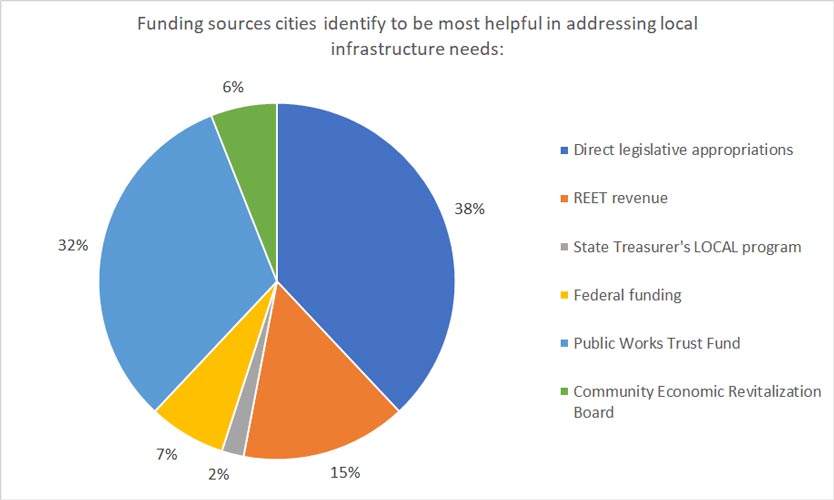
Source: 2021 AWC City Conditions Survey, 106 responses

Transportation
More than 90% of cities identified maintenance and preservation as their number one transportation-related priority, tracking closely with the feedback AWC has received from previous data collection efforts. Notably, however, more than
80% of cities also identified pedestrian access and safety as their second priority.
Many of the key revenue sources identified below provide state investment to these projects and priorities, but cities encounter significant challenges when using federal grant programs to support their transportation systems. In fact, of the cities that
have received federal transportation-related funds, 48% have diverted funds from an existing project or program just to meet the federal match requirements. This can cause significant project delays, or worse—cancelling a crucial transportation
project altogether.
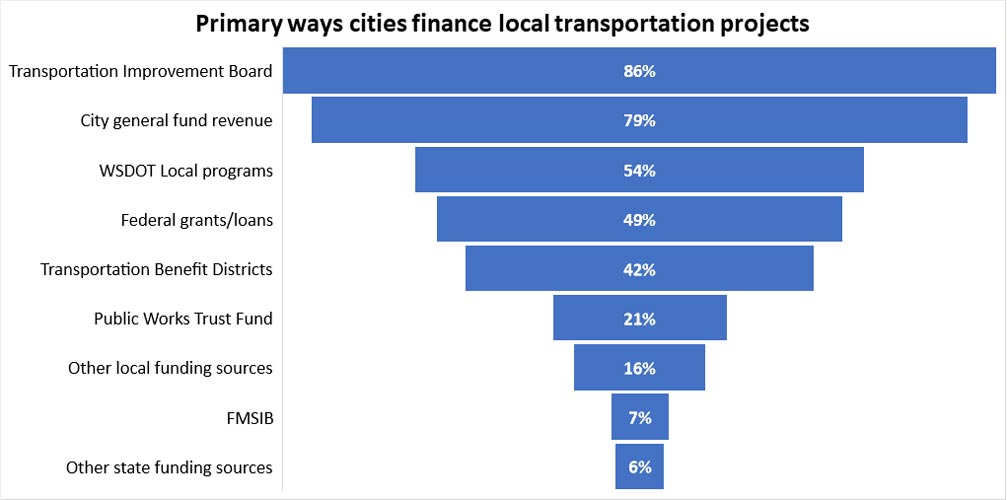
Source: 2021 AWC City Conditions Survey, 121 responses
 44% of cities use or are considering using an equity lens on local transportation policies.
44% of cities use or are considering using an equity lens on local transportation policies.

Housing & homelessness
For years, Washington cities of every size and location have grappled with the lack of available affordable housing in their communities.
- 72% of cities list affordable housing as major concern.
Source: 2021 AWC City Conditions Survey, 124 responses
Contrary to some rhetoric around housing, the cost of construction, cost of land, and urban growth area (UGA) constraints all surpassed the issue of community opposition when cities identified their top barriers. In fact, 73% of cities do not report community opposition to growth in their top three barriers to housing, but both sides of the state list cost of construction as their top barrier.
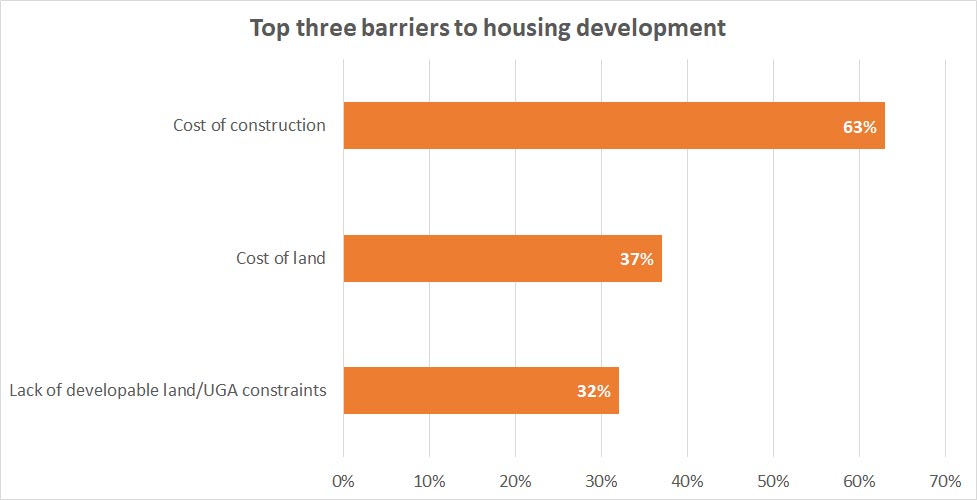
Source: 2021 AWC City Conditions Survey, 115 responses
Additionally, both Eastern and Western Washington lack shelter capacity to house those without homes and require direct state action to address the barriers.
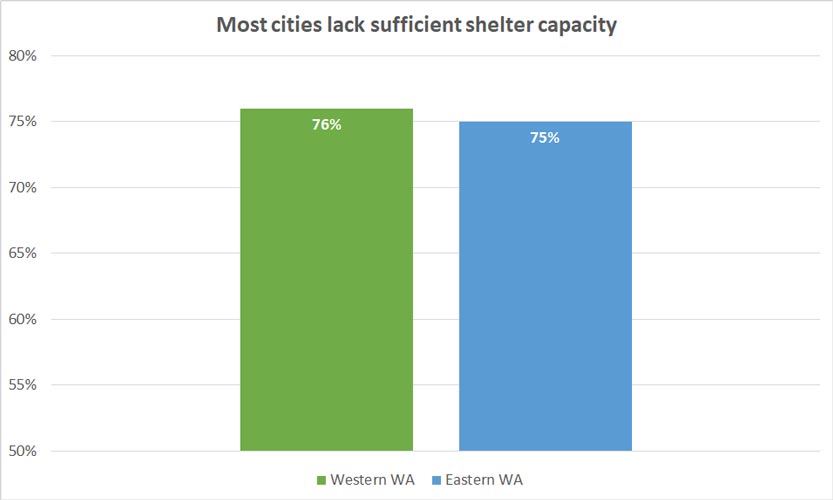
Source: 2021 AWC City Conditions Survey, 122 responses
Cities have stepped up to address the affordable housing crisis through local actions on zoning and development regulations. But as many cities reported, housing policy changes haven't been in place long enough to determine whether they have been effective
in addressing barriers to affordable housing development.

Public safety
In response to the police reform laws passed during the 2021 legislative session, 80% of police departments around the state view adapting to these changes as one of their biggest challenges in 2022. Additionally, police departments expressed
concerns about additional changes that may be coming in future legislative sessions, with 68% departments indicating future legislative mandates will pose a major challenge for them in 2022.
Hiring new officers is also a major concern for departments statewide. 64% of departments indicated that hiring new officers is one of their main concerns in 2022. However, these numbers did vary depending on where the departments are
located. On the west side, more departments see hiring as a challenge than east side departments.
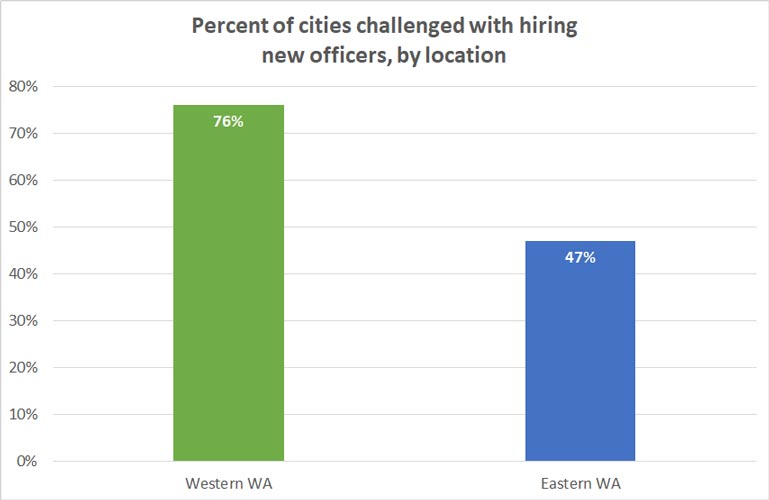
Source: 2021 AWC City Conditions Survey, 66 responses
The geographical divide was also evident in the responses related to officer retention. 62% of west side departments saw turnover as a major concern while only 21% of east side departments flagged the same concern.
Despite a nationwide conversation about defunding law enforcement in 2020, 70% of Washington cities indicate they will maintain their current law enforcement budgets in 2022. The remaining 30% of cities plan to increase
their 2022 budgets.

Human resources
- About 18% of cities report some kind of COVID-19 vaccination policy in place.
Source: 2021 AWC City Conditions Survey, 124 responses
In addition to the 18% of cities that reportedly have some sort of vaccination policy in place, another 14% of cities state intent to implement one. This is on par with other surveys that AWC has done on vaccine policies.
About 68% of respondents said they did not have a vaccination policy in place. It is important to note, however, that this question was asked prior to President Biden’s announcement of a federal vaccine mandate for all employers
with over 100 employees. Of the respondents that said they did not have a vaccination policy in place, 29 (about 23% of all responses) are cities with a population over 10,000 and thus are more likely to have a workforce large enough to fall under
the President’s mandate.
- 54% of cities reported in this year’s survey that they were struggling to recruit and fill vacancies in their city workforce.
Source: 2021 AWC City Conditions Survey, 122 responses
This is consistent with reports that we have seen throughout the economy about a tight labor market during the COVID-19 recovery. A combination of lower pay, workers changing careers, lack of childcare, and availability of enhanced unemployment benefits
prior to September 2021 are all widely mentioned potential factors in recruiting difficulties for many positions (especially lower paid) in the larger economy.
However, it is important to note that some of the response might not necessarily be tied to the pandemic recovery labor market. In a follow-up question in this year's survey:
- 61% of cities report specific trouble in recruiting for public safety positions like police;
- 60% of cities report that public works is another difficult recruiting area; and
- 35% of cities report general government & administration as the third-most difficult recruiting area.
It should be noted that previous surveys have shown that cities have struggled to fill public safety and public works positions even prior to the pandemic. There has been a sea-change in much of the public safety sector over the last several years, especially
in policing, and other data has shown that a disproportionately large number of the public safety workers were already at or near retirement age prior to the pandemic and recent efforts at police reform. Previous surveys have also shown a difficulty
for some cities to recruit for a number of public works positions over recent years, likely due to a lack of qualified and properly credentialed applicants and competition with the private sector.

Diversity, equity, and inclusion in cities
Cities throughout Washington have spent time in the last year researching and engaging in opportunities and intentional actions to promote diversity, equity, and inclusion (DEI) for all our residents.
- 87% of cities report that city leadership supports DEI conversations in the city.
Source: 2021 AWC City Conditions Survey, 87 responses - 76% of Washington cities say their city has expressed a commitment to DEI.
Source: 2021 AWC City Conditions Survey, 92 responses - 57% of cities have created or are considering creating training opportunities for city employees and elected officials around DEI best practices.
Source: 2021 AWC City Conditions Survey, 115 responses
Still, most city survey respondents have not created or started a diversity, equity, and inclusion plan at their cities.

Source: 2021 AWC City Conditions Survey, 103 responses
Budgeting equity is another opportunity area where cities can make strides in change. Our survey found that 20 percent and fewer of Washington’s cities are using the following equity approaches in city budgeting.
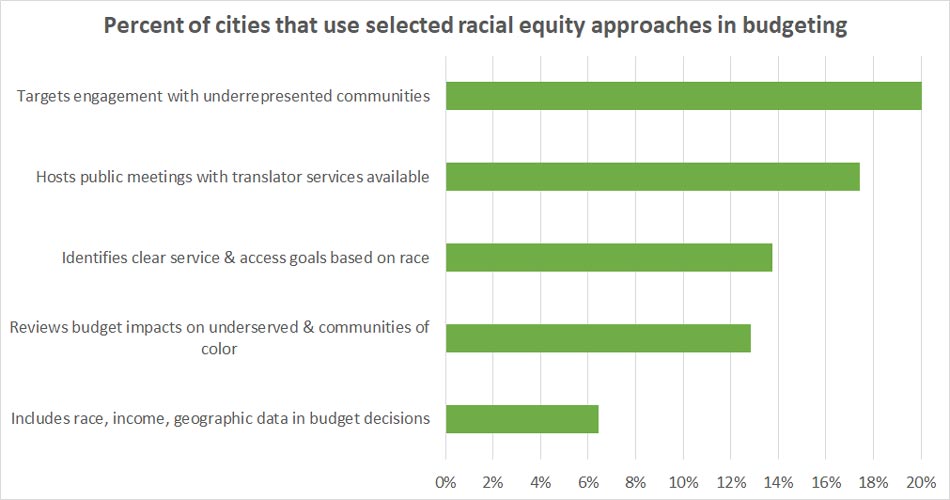
Source: 2021 AWC City Conditions Survey, 109 responses
Some cities are looking closely at internal and external DEI programs and initiatives and have hired or assigned city employees to handle the workload.
- 14% of cities have hired or assigned a full-time employee to work on city DEI programs and initiatives.
Source: 2021 AWC City Conditions Survey, 118 responses
Conclusion
This year’s survey tells us that while cities continue to innovate during the pandemic recovery, cities also face largely the same hurdles as in prior years.
City leaders should take time this fall to reach out to legislators and share this data as well as specific examples of the barriers and needs your city faces. View our 2022 City Legislative Priorities and if you’d like some tips and tricks for advocating for your city, check out the advocacy tools on our website.
Through ongoing recovery, city leaders are meeting the challenges and taking bold action to maintain and improve the quality of life for residents. We tip our hats to your hard work as you continue to adapt and deliver quality services to your community.
Thank you!
A big thanks goes out to cities for taking the time to complete our survey this year!
Cities that submitted responses ahead of the survey deadline were entered to win a prize. Winnings included a free AWC conference registration, a free AWC JobNet posting package, an AWC event scholarship, gift cards and more. Congratulations to the following
winners of this year’s City Conditions Survey prize drawings!
Chewelah | La Center |
College Place | Mercer Island |
Coupeville | North Bend |
Creston | Ocean Shores |
Kirkland | Port Orchard |
Again, thank you to everyone for participating. Your responses play an invaluable part in helping us serve your city or town. If you missed out, check your email inbox next fall to take part in our 2022 survey.